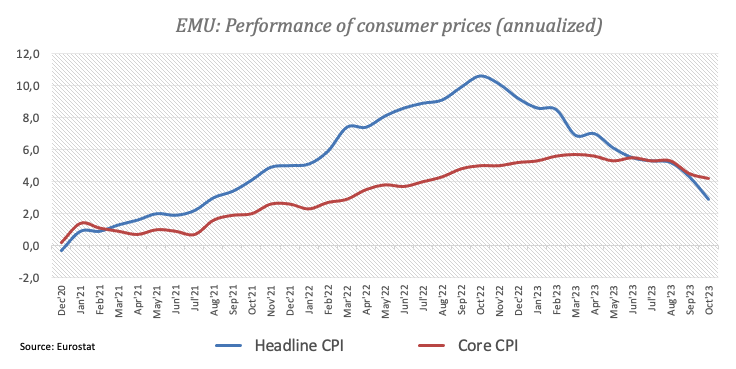Euro advances to daily highs near 1.0880 prior to Fedspeak, US data

- The Euro resumes the upside against the US Dollar.
- European stocks keep the positive bias so far on Friday.
- EMU final CPI matched the preliminary prints in October.
The Euro (EUR) regains some upside momentum against the US Dollar (USD), prompting EUR/USD to flirt once again with the 1.0880 region at the end of the week.
The Greenback, on the other side of the equation, faces increasing selling pressure and puts the key 104.00 support to the test amidst the generalized upbeat tone in the risk-linked galaxy and diminishing US yields across different timeframes. Speculation that the Federal Reserve (Fed) might start reducing its interest rates around the spring of 2024 remains well on the rise and underpins the downward bias in the index.
This speculation regarding prospective Fed rate cuts has been heightened as a result of weaker-than-expected inflation indicators (CPI and PPI) released earlier this week.
In the domestic calendar, final Inflation Rate for the broader Eurozone showed no surprises after the headline CPI rose 2.9% in the year to October and 4.2% when it came to the Core CPI.
In the US, Building Permits and Housing Starts will be in the centre of the debate. In addition, FOMC Vice Chair Michael Barr (permanent voter, centrist), Boston Fed President Susan Collins (2025 voter, centrist), Chicago Fed President Austan Goolsbee (voter, centrist) and San Francisco Fed President Mary Daly (2024 voter, hawk) are all due to speak.
Daily digest market movers: Euro looks to extend weekly gains
- The EUR now appears bid against the USD on Friday.
- US and German yields extend the decline at the end of the week.
- Markets believe the Fed will cut rates in the first quarter of 2024.
- Investors expected a prolonged pause by the ECB.
- Speculation of FX intervention continue to swirl around USD/JPY.
- ECB’s Villeroy said an impasse in the hiking cycle was fully justified.
- The US housing sector will be in the limelight later in the session.
Technical Analysis: Euro’s outlook remains constructive above 1.0800
EUR/USD seems to have embarked on a consolidation phase, trading below 1.0900.
Prior hitting the weekly high of 1.0945 (August 30) and the psychological threshold of 1.1000, the next goal of note for EUR/USD is the November top of 1.0895 (November 16). Further north, the pair might confront the August peak of 1.1064 (August 10) and another weekly high of 1.1149 (July 27), both of which precede the 2023 top of 1.1275 (July 18).
Occasionally, the pair may attempt temporary support at the 55-day Simple Moving Average (SMA) at 1.0639, before the weekly low of 1.0495 (October 13) and the 2023 low of 1.0448 (October 15).
Looking at the larger picture, the pair’s outlook should remain favourable as long as it stays above the 200-day SMA at 1.0803.
ECB FAQs
The European Central Bank (ECB) in Frankfurt, Germany, is the reserve bank for the Eurozone. The ECB sets interest rates and manages monetary policy for the region.
The ECB primary mandate is to maintain price stability, which means keeping inflation at around 2%. Its primary tool for achieving this is by raising or lowering interest rates. Relatively high interest rates will usually result in a stronger Euro and vice versa.
The ECB Governing Council makes monetary policy decisions at meetings held eight times a year. Decisions are made by heads of the Eurozone national banks and six permanent members, including the President of the ECB, Christine Lagarde.
In extreme situations, the European Central Bank can enact a policy tool called Quantitative Easing. QE is the process by which the ECB prints Euros and uses them to buy assets – usually government or corporate bonds – from banks and other financial institutions. QE usually results in a weaker Euro.
QE is a last resort when simply lowering interest rates is unlikely to achieve the objective of price stability. The ECB used it during the Great Financial Crisis in 2009-11, in 2015 when inflation remained stubbornly low, as well as during the covid pandemic.
Quantitative tightening (QT) is the reverse of QE. It is undertaken after QE when an economic recovery is underway and inflation starts rising. Whilst in QE the European Central Bank (ECB) purchases government and corporate bonds from financial institutions to provide them with liquidity, in QT the ECB stops buying more bonds, and stops reinvesting the principal maturing on the bonds it already holds. It is usually positive (or bullish) for the Euro.
